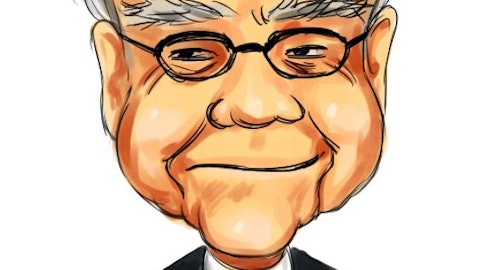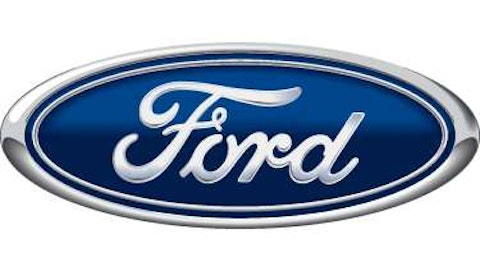
Ford’s strong new Fusion has been stealing sales from Toyota Motor Corporation (ADR) (NYSE:TM)’s Camry all year — but now Toyota is in a prime position to push back, thanks to the Japanese government. Photo credit: Ford Motor Company (NYSE:F).
Building on concerns expressed by CEO Alan Mulally back in June, Ford Motor Company (NYSE:F)’s Americas chief, Joe Hinrichs, told Bloomberg this week that the weakened yen was allowing Ford Motor Company (NYSE:F)’s Japanese rivals to crank up imports — just as Ford Motor Company (NYSE:F)’s own factories are straining to keep up with demand.
What’s the deal? And is this really likely to hurt Ford Motor Company (NYSE:F)?
How an exchange-rate shift can give Toyota a big advantage over Ford
Here’s the background. Starting late last year, Japan’s government made a series of moves to “devalue” the yen — to make it worth less versus currencies like the U.S. dollar and the euro. The idea was to help boost Japan’s economy, by making it easier for Japanese companies to compete in export markets.
How does that work? Well, when we say the yen has been devalued, what we mean is that the exchange rates have moved in such a way that companies such as Toyota Motor Corporation (ADR) (NYSE:TM) can get more yen for the dollars they earn in places like the United States.
At the beginning of 2013, one dollar bought about 86 yen. Now, a dollar would buy almost 99 yen. That means that every dollar earned by a Japanese company in the U.S. is worth more money at home. And that means the Japanese companies can charge fewer dollars for their products and still have a nice profit when those dollars are converted to yen.
For a company such as Toyota Motor Corporation (ADR) (NYSE:TM) or Honda Motor Co Ltd (ADR) (NYSE:HMC) that has the ability to produce cars in both the U.S. and Japan, it also means that it may be cheaper at the moment — meaning more profitable — to build cars in Japan and send them over here.
That doesn’t mean Toyota Motor Corporation (ADR) (NYSE:TM) or the other Japanese automakers will stop building cars in their U.S. factories. But it does mean that they can ship extra cars over here, giving their dealers more to sell — at, possibly, lower prices.
Meanwhile, Ford — and increasingly, General Motors Company (NYSE:GM) as well — is kind of in the opposite situation.
Ford’s factories are close to maxed out
Ford’s problem is that it is running into “capacity constraints” here in North America. Put another way, that means that Ford’s factories are having trouble keeping up with demand for some of the company’s hottest products, even though several of those factories are working around the clock.
With demand for new vehicles steadily rising in the U.S., Ford is concerned that the Japanese makers will be able to flood the market with cheaper cars just as the Blue Oval is struggling to keep up.
And it’s on the verge of struggling to keep up: Ford has warned that supplies of its white-hot Fusion sedan, which has been stealing sales and market share from Toyota’s Camry for much of the year, will be very tight until a second assembly line starts up in Michigan this fall. Ford has also added extra production of its F-Series pickups, which have been selling very briskly, and there are increasing signs of tight supplies of the Escape, the Explorer, and the Focus as well.
In time, Ford should be able to juggle its global production to keep up with demand here in the United States. But that will take time, and it could take a substantial amount of money if Ford has to add additional assembly lines, as it is doing with the Fusion.
Expect Toyota to be very aggressive here
Meanwhile, there are more and more signs that Toyota is getting aggressive about trying to take back market share in the United States. Toyota has lost ground here this year as more competitive models from Honda Motor Co Ltd (ADR) (NYSE:HMC), Ford, and Nissan Motor Co., Ltd. (ADR) (OTCMKTS:NSANY) have cut into sales of its bread-and-butter vehicles such as the Camry and Corolla.
Nissan Motor Co., Ltd. (ADR) (OTCMKTS:NSANY) has already taken advantage of the exchange-rate swing. It cut prices on several models back in May and has seen a sizable increase in U.S. sales since. But Toyota is making it clear that it plans to defend the Camry’s position as America’s best-selling car, a position that is being threatened by Honda Motor Co Ltd (ADR) (NYSE:HMC)’s strong new Accord.
Right now, Ford can’t make enough Fusions to regain that title (which Ford’s old Taurus held for years). That could change in a few months, once its new assembly line is up to speed. But with Toyota willing to be aggressive on pricing — and with Toyota and the other Japanese automakers having plenty of excess manufacturing capacity back at home in Japan — this battle could continue to be a tough one for the Blue Oval.
The article Ford Is Still Angry About Japan’s Yen originally appeared on Fool.com is written by John Rosevear.
Fool contributor John Rosevear owns shares of Ford and General Motors. You can connect with him on Twitter at @jrosevear.The Motley Fool recommends Ford and General Motors and owns shares of Ford.
Copyright © 1995 – 2013 The Motley Fool, LLC. All rights reserved. The Motley Fool has a disclosure policy.





